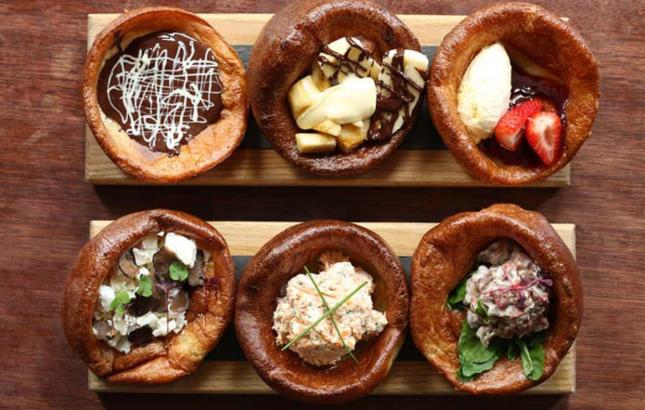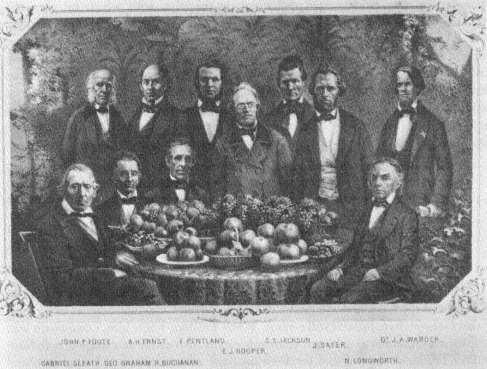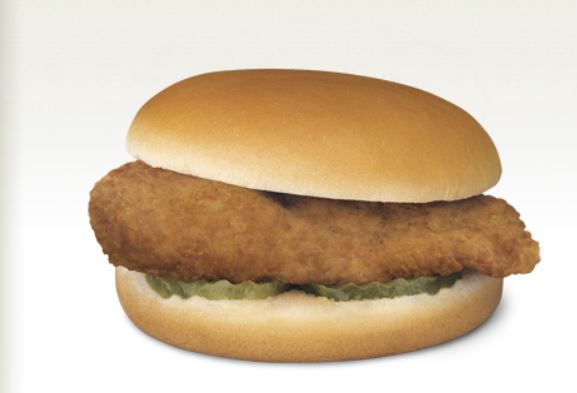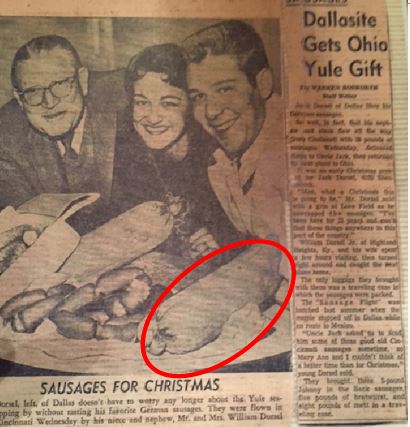
Yorkshire pudding flights from Reform Social & Grill, U.K.
Savory is the new sweet – especially in the dough world. Savory bacon found its way into desserts several years back. Pork liver found its way into dessert caramel. Both of those trends, thankfully, have hit their height and gone. But now, smart chefs are taking a new trend to heart by taking comfort breads and making them bite-sized and savory with upscale ingredients.
Take the Yorkshire pudding for example. It’s not a pudding at all by American definition. It’s a savory bread, soufflé really, invented in the UK, that originated as a bread baked under a rotisserie. The hot drippings from the roast were mixed in with the dough below. Originally it was served as a first course to fill up the eater so they ate less of the expensive meat. Now it’s a staple of the English Sunday roast.
Restaurants like Reform Social & Grill is offering a flight of six savory bite-sized Yorkshire puds. They range from a salt beef, horseradish and watercress, a hot smoked salmon, cream cheese and chive version, to a Tunworth Cheese and truffle. These can go in a variety directions. What about a duck and hoisin, to go Asian-Fusian. Chicken vindaloo or curry would be a nice touch. You could take it southern and have a pimento cheese and bacon version. And you could even go all Cincinnati and have a goetta and beer cheese pud. The opportunities seem endless – I offer this for free to Chefs Salazar and Kelly – GO!
But then you have a very similar dish in the Dutch pannekoeken or pancake. It’s similar to the Yorkshire pudding in that it’s very light, but eggy, and not the dense pancake that we’re used to seeing at Waffle House or IHOP in the U.S.
I had my very first savory pannekoeken in Utrecht, Holland, at De Oude Muntkelder, with my friend Debbie, who grew up on them in Amsterdam. It was a little café built into the bridge on the canal that was once a receiving warehouse to merchants. I had the Indonesian pannekoeken, which had chicken, and sauteed mushroom, onion, and leek, covered in a yummy spicy peanut sauce. It was like stepping into a whole new savory world. I bought a special pannekoeken skillet and had Debbie bring back real Dutch pannekoeken mix and made my own. Man were they good!
http://www.deoudemuntkelder.nl/en/menu/pancakes/
A few years later I found the Canadian chain De Dutch in Vancouver, that serves all pannekoeken, all day. Founded by none other than a Dutch immigrant – It too was amazing. They have traditional versions– like the Amsterkoeken with eggs, edam cheese, and ham with hollandaise sauce. Then there’s what I had – the Windmill – a smoked salmon, edam and hollandaise drenched version. It sounds decadent, but it has less calories and carbs than bagels and lox, I can assure you.

A De Dutch savory pannekoeken.
Although pannekoeken can be wrapped like a crepe (although they’re not quite as thin as a crepe) and cut into little sort of pinwheels, the Dutch eat them flat and sprawled out on a plate with knife and fork. But they can be made in muffin sized versions like the savory Yorkshires and served in a flight.
Both the savory Yorkshire and the Pannekoeken are legs up on our American savory version – the fried chicken and waffle, or the local Belgian Liege version we’re familiar with in Cincinnati– sorry Jean-Francois! And there’s really no room for variation on this domestic version, unless you do something to the breading or the marinade, like make it a Nashville spicy chicken and waffles. That doesn’t seem like enough room for creativity.
I hope local chefs take this ‘flighting’ of small savory breads to heart and offer us some creative bites this year!!








 Nashville Hot in Crescent Springs, Kentucky.
Nashville Hot in Crescent Springs, Kentucky.







